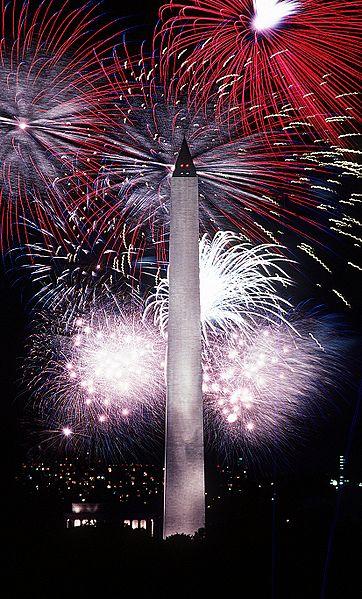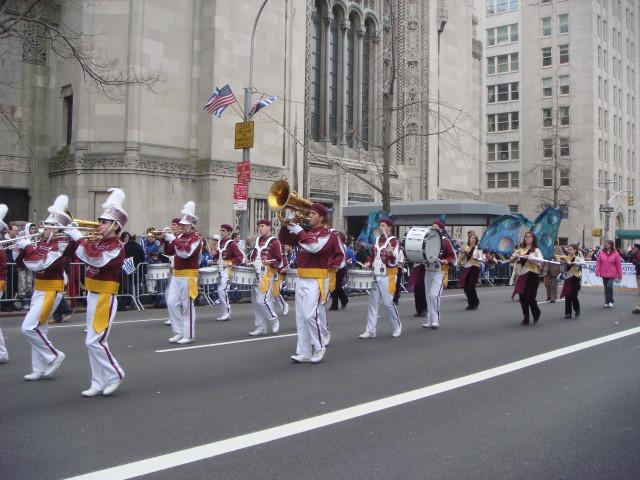
- •Holidays in the usa
- •1. Federal holidays in the United States
- •New Year’s Day
- •Martin Luther King’s Day
- •George Washington’s Birthday
- •Memorial Day
- •Independence Day
- •Labor Day
- •Columbus Day
- •Veteran’s Day
- •Thanksgiving
- •Christmas
- •2. Other holidays in the usa
- •3. Ethnic and religious observances
- •Glossary
- •Comprehension
- •Self-Assessment
- •Further Reading
Independence Day
Independence Day is regarded as the birthday of the United States as a free and independent nation. Most Americans simply call it the “Fourth of July”, on which date it always falls.
Historical background of the holiday
The holiday recalls the signing of the Declaration of Independence on July 4, 1776. At that time, the people of the 13 British colonies located along the eastern coast of what is now the United States were involved in a war over what they considered unjust treatment by the king and parliament in Britain. The war began in 1775. As the war continued, the colonists realized that they were fighting not just for better treatment; they were fighting for freedom from England’s rule. The Declaration of Independence, signed by leaders from the colonies, stated this clearly, and for the first time in an official document the colonies were referred to as the United States of America.
Current customs and traditions
Independence Day is a national holiday marked by patriotic displays. Similar to other summer-themed events, Independence Day celebrations often take place outdoors. Independence Day is a federal holiday, so all non-essential federal institutions (like the postal service and federal courts) are closed on that day. Many politicians make it a point on this day to appear at a public event to praise the nation’s heritage, laws, history, society, and people.
Families often celebrate Independence Day by hosting or attending a picnic or barbecue, and take advantage of the day off and in some years, long weekend to gather with relatives. Decorations (e.g., streamers, balloons, and clothing) are generally colored red, white, and blue, the colors of the American flag. Parades often are in the morning, while fireworks displays occur in the evening at such places as parks, fairgrounds, or town squares.
Independence Day fireworks are often accompanied by patriotic songs such as the national anthem (“The Star-Spangled Banner”), “God Bless America”, “America the Beautiful”, “This Land Is Your Land”, “Stars and Stripes Forever”, and, regionally, “Yankee Doodle” in northeastern states and “Dixie” in southern states. Some of the lyrics recall images of the Revolutionary War or the War of 1812.


-
Displays of fireworks, such as these over the Washington Monument, are an example of the celebrations that take place nationwide
Fourth of July Parade
Labor Day
This holiday, which always is observed on the first Monday of Septemberhas been a federal holiday since 1894, but was observed in some places before that day as a result of a campaign by an early organization of workers called the Knights of Labor. Its purpose is to honor the nation’s working people.
Historical background of the holiday
Eleven-year-old Peter McGuire sold papers on the street in New York City. He shined shoes and cleaned stores and later ran errands. It was 1863 and his father, a poor Irish immigrant, had just enlisted to fight in the Civil War. Peter had to help support his mother and six siblings.
Many immigrants settled in New York City in the nineteenth century. They found that living conditions were not as wonderful as they had dreamed. Often there were six families crowded into a house made for one family. Thousands of children had to go to work. Working conditions were even worse. Immigrant men, women and children worked in factories for ten to twelve hours a day, stopping only for a short time to eat. They came to work even if they were tired or sick because if they didn’t, they might be fired. Thousands of people were waiting to take their places.
When Peter was 17, he began an apprenticeship in a piano shop. This job was better than his others, for he was learning a trade, but he still worked long hours with low pay. At night he went to meetings and classes in economics and social issues of the day. One of the main issues of concern pertained to labor conditions. Workers were tired of long hours, low pay and uncertain jobs. They spoke of organizing themselves into a union of laborers to improve their working conditions. In the spring of 1872, Peter McGuire and 100 000 workers went on strike and marched through the streets, demanding a decrease in the long working day.
This event convinced Peter that an organized labor movement was important for the future of workers’ rights. He spent the next year speaking to crowds of workers and unemployed people, lobbying the city government for jobs and relief money. It was not an easy road for Peter McGuire. He became known as a “disturber of the public peace”. The city government ignored his demands. Peter himself could not find a job in his trade. He began to travel up and down the east coast to speak to laborers about unionizing. In 1881, he moved to St Louis, Missouri, and began to organize carpenters there. He organized a convention of carpenters in Chicago, and it was there that a national union of carpenters was founded. He became General Secretary of the United Brotherhood of Carpenters and Joiners of America.
The idea of organizing workers according to their trades spread around the country. Factory workers, dock workers and toolmakers all began to demand and get their rights to an eight-hour workday, a secure job and a future in their trades. Peter McGuire and laborers in other cities planned a holiday for workers on the first Monday in September, halfway between Independence Day and Thanksgiving Day.
On September 5, 1882 the first Labor Day parade was held in New York City. Twenty thousand workers marched in a parade up Broadway. They carried banners that read “LABOR CREATES ALL WEALTH”, and “EIGHT HOURS FOR WORK, EIGHT HOURS FOR REST, EIGHT HOURS FOR RECREATION!” After the parade there were picnics all around the city. Workers and celebrants ate Irish stew, homemade bread and apple pie. At night, fireworks were set off. Within the next few years, the idea spread from coast to coast, and all states celebrated Labor Day. In 1894, Congress voted it a federal holiday.
Current customs and traditions
Today, Labor Day is often regarded as a day of rest and parades. Speeches or political demonstrations are more low-key than May 1 Labour Day celebrations in most countries, although events held by labor organizations often feature political themes and appearances by candidates for office, especially in election years. Forms of celebration include picnics, barbecues, fireworks displays, water sports, and public art events. Families with school-age children take it as the last chance to travel before the end of summer. Some teenagers and young adults view it as the last weekend for parties before returning to school. However, of late, schools have begun well before Labor Day, as early as July 24 in many urban districts, including major southern cities in the United States such as Atlanta, Miami, and Los Angeles. In addition, Labor Day marks the beginning of the season for the National Football League and NCAA College Football. The NCAA usually plays their first games the week before Labor Day, with the NFL traditionally playing their first game the Thursday following Labor Day.
